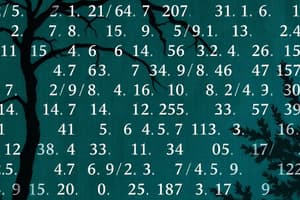Podcast
Questions and Answers
What is a complex rational expression?
What is a complex rational expression?
A rational expression that contains rational expressions within its numerator and/or its denominator.
What is the first step in simplifying a complex rational expression using Method 1?
What is the first step in simplifying a complex rational expression using Method 1?
Find the LCM of all the denominators of all the rational expressions occurring within both the numerator and the denominator of the original complex rational expression.
After finding the LCM in Method 1, what is the next step in simplifying a complex rational expression?
After finding the LCM in Method 1, what is the next step in simplifying a complex rational expression?
Multiply by 1 using LCM/LCM.
In Method 2 for simplifying complex rational expressions, what follows simplifying the numerator and denominator?
In Method 2 for simplifying complex rational expressions, what follows simplifying the numerator and denominator?
Define the term 'difference quotient'.
Define the term 'difference quotient'.
Simplify this complex rational expression: $\frac{\frac{1}{x} + \frac{1}{y}}{\frac{x + y}{xy}}$
Simplify this complex rational expression: $\frac{\frac{1}{x} + \frac{1}{y}}{\frac{x + y}{xy}}$
Simplify the complex rational expression: $\frac{\frac{a}{b} - \frac{b}{a}}{\frac{1}{a} + \frac{1}{b}}$
Simplify the complex rational expression: $\frac{\frac{a}{b} - \frac{b}{a}}{\frac{1}{a} + \frac{1}{b}}$
Find the difference quotient for $f(x) = 3x + 2$.
Find the difference quotient for $f(x) = 3x + 2$.
Determine the difference quotient for $f(x) = x^2 + 1$.
Determine the difference quotient for $f(x) = x^2 + 1$.
What is the significance of h approaching 0 in the context of the difference quotient?
What is the significance of h approaching 0 in the context of the difference quotient?
Given $f(x) = \frac{1}{x}$, find and simplify the difference quotient.
Given $f(x) = \frac{1}{x}$, find and simplify the difference quotient.
What is the difference quotient of $f(x)=c$, where $c$ is a constant?
What is the difference quotient of $f(x)=c$, where $c$ is a constant?
Determine the difference quotient of the function $f(x) = \sqrt{x}$. (Hint: Rationalize the numerator.)
Determine the difference quotient of the function $f(x) = \sqrt{x}$. (Hint: Rationalize the numerator.)
Consider a scenario where the difference quotient, calculated as $\frac{f(x + h) - f(x)}{h}$, equals zero for all values of $x$ and $h$ (where $h \neq 0$). What can be definitively concluded about the nature of the function $f(x)$? Be as precise as possible.
Consider a scenario where the difference quotient, calculated as $\frac{f(x + h) - f(x)}{h}$, equals zero for all values of $x$ and $h$ (where $h \neq 0$). What can be definitively concluded about the nature of the function $f(x)$? Be as precise as possible.
Flashcards
Complex Rational Expression
Complex Rational Expression
A rational expression containing rational expressions in its numerator, denominator, or both.
Simplifying Complex Rationals (Method 1)
Simplifying Complex Rationals (Method 1)
Find the LCM of all denominators, multiply the complex rational expression by LCM/LCM, and simplify.
Simplifying Complex Rationals (Method 2)
Simplifying Complex Rationals (Method 2)
Add/subtract to get a single rational expression in both the numerator and the denominator. Then, divide the numerator by the denominator and simplify.
Difference Quotient
Difference Quotient
Signup and view all the flashcards
Finding f(x + h)
Finding f(x + h)
Signup and view all the flashcards
Study Notes
Complex Rational Expressions
- A complex rational expression contains rational expressions within its numerator and/or its denominator
Simplifying Complex Rational Expressions - Method 1
- Find the Least Common Multiple (LCM) of all denominators within the complex rational expression
- Multiply the complex rational expression by 1, using LCM/LCM
- Simplify if possible
Simplifying Complex Rational Expressions - Method 2
- Add or subtract to get a single rational expression in the numerator
- Add or subtract to get a single rational expression in the denominator
- Divide the numerator by the denominator
- Simplify the result if possible
Difference Quotient
- The difference quotient, also known as the average rate of change, is given by:
- [f(x + h) - f(x)] / h
Studying That Suits You
Use AI to generate personalized quizzes and flashcards to suit your learning preferences.




